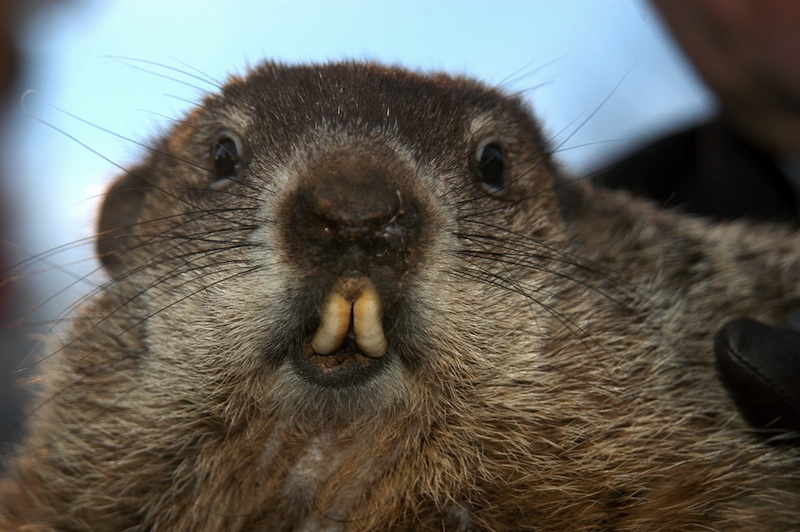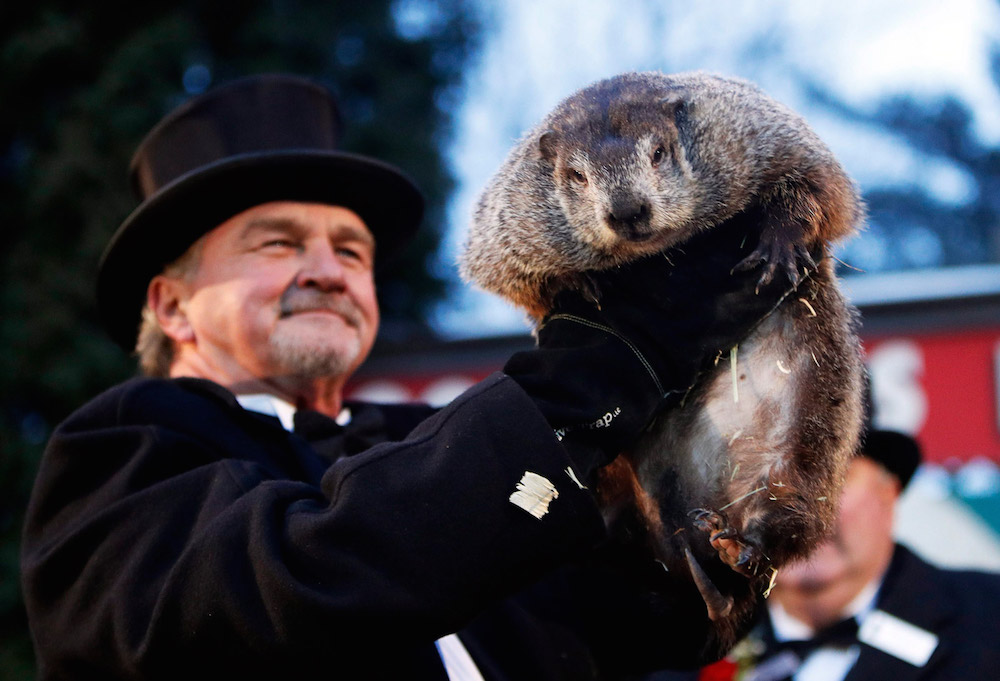Facts about groundhogs
Groundhogs, also called woodchucks, are large rodents. Traditionally, their shadows are used to predict when winter will end.

Groundhogs (Marmota monax), also called woodchucks, are large rodents. They are also one of the 14 species of marmot, or ground squirrels. In fact, they are the largest members of the squirrel family. Most people probably know the groundhog as a weather prognosticator because of Groundhog Day. However, those predictions are typically not very good.
Groundhog size
From head to rump, groundhogs are 17.75 to 24 inches (45 to 61 centimeters) long, according to National Geographic. They weigh around 13 pounds (6 kilograms), which is about twice the average weight of a newborn human baby. Like other squirrels, groundhogs have long tails that grow around 7 to 9.75 in (18 to 25 cm) long.
These round creatures look like little bears when they stand up on their hind legs. Groundhogs also have sharp claws that they use to dig impressive burrows in the ground. During the warm months, a groundhog's incisors continue to grow each week to keep up with their frenzied eating schedule, according to the National Wildlife Federation. If they aren't worn down enough by chewing that can be fatal to the overgrown squirrels, according to the NWF.
Groundhog habitat
Groundhogs are found only in North America, from Canada down to the southern United States, according to AnimalDiversity.org. They like woodland areas that bump up against more open areas. They dig burrows that can be 6 feet (1.8 meters) deep, and 20 feet (6 m) wide. These underground homes can also have two to a dozen entrances, according to the National Wildlife Federation. Typically, they have a burrow in the woods for the winter and a burrow in grassy areas for the warmer months. Groundhogs keep their burrows tidy by changing out the nesting found inside from time to time.
Groundhog habits
Groundhogs are solitary creatures, and they spend their summers and falls stuffing themselves and taking naps in the sun.
In the winter, they hibernate. While hibernating, the groundhog's heartbeat slows from 80 beats per minute to 5 beat per minute; their respiration reduces from 16 breaths per minute to as few as 2 breaths per minute; and their body temperature drops from about 99 degrees Fahrenheit (37.2 degrees Celsius) to as low as 37 F (2.77 C), according to the National Wildlife Federation.
A groundhog typically sticks close to home. They usually don't wander farther than 50 to 150 feet (15 to 30 m) from their den during the daytime, according to the Internet Center for Wildlife Damage Management.
Get the world’s most fascinating discoveries delivered straight to your inbox.
Groundhog diet
These rodents are herbivores, which means they eat vegetation. A groundhog's diet can include fruit, plants, tree bark and grasses. They are known for damaging crops and gardens and many consider them pests.
Groundhogs don't eat during hibernation. They use fat that they built up over the summer and winter month.
Groundhog offspring
In February, males will come out of hibernation and search for females' burrows. When he finds one, he heads on in. It is believed that males do this to introduce themselves to possible mates. In the spring, mating season progresses and the females give birth to two to six young after a gestation period of around 32 days.
The babies are blind and hairless, but quickly become mature in just three months or so. When they are mature, they typically leave their mother to dig their own homes. Groundhogs in the wild live around three to six years, according to PBS.org.
Groundhog classification/taxonomy
Here is the classification for groundhogs, according to the Integrated Taxonomic Information System (ITIS):
Kingdom: Animalia
Subkingdom: Bilateria
Infrakingdom: Deuterostomia
Phylum: Chordata
Subphylum: Vertebrata
Infraphylum: Gnathostomata
Superclass: Tetrapoda
Class: Mammalia
Subclass: Theria
Infraclass: Eutheria
Order: Rodentia
Suborder: Sciuromorpha
Family: Sciuridae
Subfamily: Xerinae
Tribe: Marmotini
Genus: Marmota
Subgenus: Marmota
Species: Marmota monax
Subspecies:
- Marmota monax bunkeri
- Marmota monax canadensis
- Marmota monax ignava
- Marmota monax johnsoni
- Marmota monax monax
- Marmota monax ochracea
- Marmota monax petrensis
- Marmota monax preblorum
- Marmota monax rufescens
Groundhog conservation status
Groundhogs are listed as least concern for extinction on the International Union for Conservation of Nature's Red List of Threatened Species. They are widespread from central Alaska, across Canada and south through the United States to Georgia, Alabama, Louisiana and Arkansas.
Groundhog shadow facts
According to tradition, if the groundhog sees its shadow on Feb. 2, there will be six more weeks of winter. This idea gave rise to Groundhog Day. The tradition of relying on rodents as forecasters may date back to the early days of Christianity in Europe, when clear skies on Candlemas Day (Feb. 2) were said to herald cold weather ahead, according to the Old Farmer's Almanac. In Germany, the tradition morphed into a myth that if the sun came out on Candlemas, a hedgehog would cast its shadow, predicting snow all the way into May. When German immigrants settled in Pennsylvania, they transferred the tradition onto local fauna, replacing hedgehogs with groundhogs.
But how accurate is this method of weather prediction? The Punxsutawney Groundhog Club, of Punxsutawney, Pennsylvania, has records from more than 100 years. On Groundhog Day, the club holds a "solemn" ceremony as a groundhog, named Phil, is pulled from a "burrow" in front of TV cameras and cheering crowds. The club says Phil has predicted 99 forecasts of more winter and 15 early springs. According to data from the Stormfax Almanac, Phil's predictions have been correct only 39% of the time in his hometown of Punxsutawney.
How much wood?
How much wood would a woodchuck chuck, if a woodchuck could chuck wood? About 700 pounds (317 kg), according to Cornell University.
Actually, the name woodchuck has nothing to do with wood, or chucking it, according to Animal Diversity Web. The word woodchuck comes from a Native American word, wuchak, which roughly translates as "digger." (Another name for this animal is whistle-pig, according to the National Museum of Natural History.)
Nevertheless, according to Cornell, a wildlife biologist sought to answer the tongue-twister's question. He measured the volume a woodchuck burrow and estimated that if the hole were filled with wood rather than dirt, the woodchuck would have chucked about 700 pounds (Woodchucks, however, typically do not chew wood.)
Additional resources




